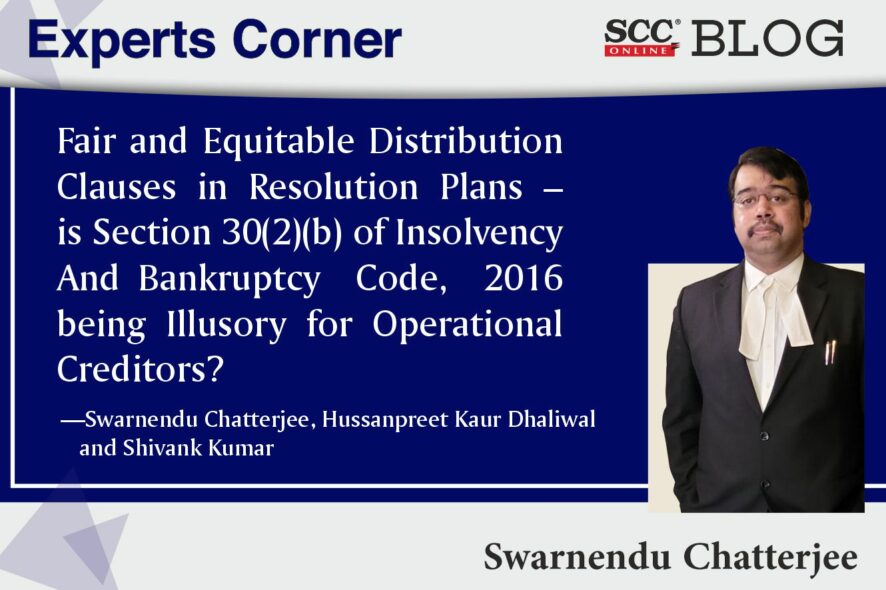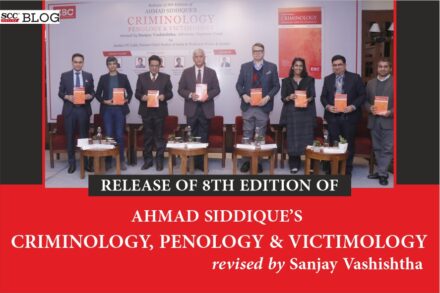The advent of the Insolvency and Bankruptcy Code, 2016 (hereinafter referred to as “IBC” or the “Code”) established legal norms of Indian capitalism which were in line with the global norms for the first time. It strives to bind the current legal process by providing basic rules and regulations for insolvency and bankruptcy.
Despite being such a viable piece of legislation, the IBC includes rules that infringe the basic principles of equality rooted in the Code. As per the IBC, financial creditors are provided more powers as only they comprise the Committee of Creditors and are given priority in the corporate insolvency resolution process (hereinafter referred to as “CIRP”) to operational creditors.
It has long been noticed in numerous rulings that the amount that operational creditors receive is significantly less than financial creditors in terms of admitted claims. Time and again, multiple applications have been filed before the courts to consider the aforesaid aspect, but in vain. The Code does not have a plausible solution to this problem.
The distinction between operational and financial creditors is elemental under the Code. When the financial and operational creditors are not secured, it is clear that discrimination, rather than differentiation, has occurred. The ultimate goal of any creditor, whether operational or financial, is to ensure maximum recovery. The IBC does not provide any mechanism for incentives to advance such change and make sure that financial creditors do not act solely in their own self-interest.
Section 30(2)(b) of the backdrop
Section 30(2)(b) of the Code, as it exists in its present form came into effect in 2019[1] and before that there was no provision in this Code which mandated the minimum value for liquidation to a dissenting financial creditor. The rule was introduced to deal with the scenarios wherein the resolution plans gave a lower amount for the dissenting financial creditors vis-a`-vis the assenting financial creditor. Dissenting financial creditors were paid nil in some of the cases.
Hence, in an attempt to lessen this practice of penalising dissent, the amendment was enacted to ensure that no dissent could be valued below its liquidation value. There is not any public data to posit that penalising the dissenting financial creditor was indeed a widespread procedure in the field, but by discovering a solution for the said exercise, the Code did end up making the classification of dissenting and assenting financial creditors legal. As a result, the Code permitted the PRAs (prospective resolution applicant) to edit in the Code that in any instance, only the liquidation value would be paid to financial creditors, even when the proposed resolution plan by the PRA fell within the scenario.
There is not any incentive for a PRA to pay more than the value of liquidation if the Code states that it is sufficient to settle the dissenting financial creditor at the value of liquidation. As a result, while the aim of Section 30(2)(b) was to curb the practice of penalising the dissenting financial creditor, but it ended up legalising such practice; thus, the said provision would only be able to attain its full import if the Code allows that a dissenting financial creditor be presented with the higher of the two values stated below:
(a) The amount proposed for the dissenting financial creditor in the resolution plan.
(b) The dissenting financial creditor’s liquidation value as per Section 53 of the Code (waterfall mechanism).
Previously, in the Insolvency Law Report 2018, the Insolvency Law Committee considered the practicability towards using “fair value” or “bid value” as options to ascertain the amount to be provided to operational creditors, but ultimately rejected such insights, citing the difficulty of payment and assessment of fair value upfront. Rather, it was considered by the Committee to keep the liquidation value as the minimum amount payable to these operational creditors. Since most resolution plans were in the process of being submitted in 2018, and there is no substantiation that operational creditors are not receiving a fair value for the admitted claims, In 2018, the Committee decided not to proceed with an amendment in this regard.
Recent judgments /judicial pronouncements
In the recent judgment of National Company Law Appellate Tribunal (NCLAT) Damodar Valley Corpn. v. Dimension Steel and Alloys (P) Ltd.,[2] an important question of law was raised; “if according to the resolution plan, the distribution to the operational creditor was fair and equitable?”
The issue stemmed from the fact that the financial creditors were able to realise 7.74% of their admitted claims, which is significantly more than the operational creditors who were able to realise 0.19% of their admitted claims. In this case, the Tribunal was presented with plans in which operational creditors either paid a negligible amount which even amounted to 1% at times or did not pay any amount towards their claim. Moreover, the operational creditors received only a fraction of their admitted claim, amounting to 0.19 percent.
As the law currently stands, no exception can be made to the plans that furnish payment to an operational creditor as per the commercial wisdom of the Committee of Creditors, in light of the judicial pronouncements by the Supreme Court.
The NCLAT in the aforesaid judgment recommended to the Board and the Government to assess the situation in order to determine whether there exist any grounds for altering the legislative scheme for paying operational creditors, which also includes statutory and government dues. The observation was made to aid the Government and other stakeholders to consider this issue and take decisions with clear parameters to guide all the stakeholders so that the objective of fair and equitable distribution can be fulfilled.
On the similar line of arguments made for equitable treatment for all creditors in Binani Industries Ltd. v. Bank of Baroda,[3] differential payments were challenged by the unsecured financial creditors and the operational creditors separately on the ground of discrimination being meted out to the creditors based on their voting share when no such discrimination is provided in the I&B Code. While establishing the law on this matter, the NCLAT stated that the I&B Code’s goal is resolution and that its intent is to maximise the value of the corporate debtor’s assets for the benefit of all creditors. Instead of maximising value for a single “stakeholder” or group of “stakeholders,” such as creditors, the goal is to encourage entrepreneurship, increase access to finance, and strike a balance between competing interests.
Interestingly, the Supreme Court in Swiss Ribbons (P) Ltd. v. Union of India,[4] dealt with the constitutional validity the differentiation between financial creditors and operational creditors and that whether such differentiation was violative of Article 14 of the Constitution of India. The Supreme Court noted that as financial creditors are in a better position than corporate debtors to evaluate the viability and feasibility of the business, the classification does not violate Article 14. While operational creditors, who only deal with the goods and services and the dues incurred with it, are not in a position to evaluate the business when compared to financial creditors, such as banks and financial institutions, who are involved in lending money.
Reinforcing the Swiss Ribbons[5] judgment, the Supreme Court did not recognise both the financial and operational creditors to be on the same pedestal as observed in Essar Steel India Ltd. v. Satish Kumar Gupta[6], where where the Supreme Court had further clarified that the principle of equality cannot be applied between financial and operational creditors as financial creditors deal with public money which has a direct effect on the economy of the country as well they indulge in the long drawn litigation process, however, the operational creditors who are basically service providers can withdraw from their commitments if there are repeated defaults in their payments. However, the aforesaid observation is proving to be a double edged sword, as the operational creditors are being left high and dry in the name of mere compliance, which is writ large from the observation of NCLAT in the judgment of Damodar Valley Corporation as mentioned above.
Contrary to the view in the above-mentioned judgment, the Supreme Court, in Maharashtra Seamless Ltd. v. Padmanabhan Venkatesh[7] held that, it is not required for the resolution plan to match the maximised asset value of the corporate debtors while highlighting the object of the Code i.e. “resolution before liquidation”, while on the other hand, Supreme Court refused to recognise the interests of operational creditors.
Analysis (position of the provision)/critique
There is little denying that if the present status quo persists and the operational creditors are not provided any significant portion of their admitted claims, then no creditor would prefer to render services or supply goods on credit to any corporate debtor as observed in Binani Industries Ltd. v. Bank of Baroda[8]. In fact, they would ask for advance payment which directly goes against the principle of the Code itself. Thus, it should be acknowledged that a balance between the weightage given to both the creditors while accepting or rejecting a resolution plan is the need of the hour.
Operational creditors do not have any control over the CIRP as they are not a part of the Committee of Creditors (hereinafter referred to as “CoC”) like financial creditors. The CoC has full authority under the law to make commercial decisions, and it is not obligatory to allocate a bigger amount to operational creditors in the resolution plan if liquidation value is nil/negligible.
It is unfortunate that the Parliament has further restricted the rights of the operational creditors rather than considering options by adding a phrase that for compliance with Section 30(2)(b) of the IBC for any resolution plan would just have to be “fair and equitable”.
The first priority for the dues owed to secured creditors along with the dues for the period of 24 months preceding the commencement date for liquidation would be given to the workmen; who are otherwise operational creditors. For the 24 months preceding the liquidation commencement date, operational creditors, being workmen, would receive first priority for their dues, along with the dues owed to a secured creditor. Secured creditors are typically financial creditors such as banks and financial institutions. However, it is possible, though extremely unlikely, that operational creditors also are secured creditors, in which case such secured operational creditors would also receive priority. Similarly, any unpaid dues and wages owed to employees who also happen to be the operational creditors, other than the workmen, are given less priority than that of workmen in respect of the dues for the twelve-month period preceding the commencement date of liquidation.
Dues owed to the Central and State Governments are also operational, and they are prioritised after the dues are paid to the unsecured financial creditors. For any unpaid amount following the enforcement of a security interest, the Government dues rank side by side with the amount owed to a secured creditor.
If there is a sense of security among the operational creditors then it will entitle them to seek payment of the balance amount after security interest is enforced. In the waterfall mechanism, those who supplies goods rank last along with the employees and workmen’s dues beyond 24 months.
In a resolution plan, the operational creditors are left high and dry i.e. they are allowed to bleed. The financial institutions/banks, who are a part of the CoC have their portion of the dues secured and in the name of the “fair and equitable clause” under Section 30(2)(b) mostly, the liquidation value is shown to be nil. Therefore, as the operational creditors cannot question the distribution mechanism or the quantum of the amount, hence, some of the resolution plans which are highly discriminatory and are just a namesake in the name of compliance are a reason for the NCLAT to make an observation in its recent judgment as mentioned above. Such a disparity and misuse in the name of compliance is actually resulting in major losses of the service providers which actually run into crores. It was never intended by the Parliament, resolution of a debt-ridden company would make its service providers and workmen bleed for no fault of theirs.
Way forward
As the law currently stands, there is not any solution to this identified problem in the Code; operational creditors, under a resolution plan are paid in accordance with the mandate under Section 30(2)(b) of the Code, which eventually results in them obtaining meagre amounts. Furthermore, there is not any mechanism in place to ascertain whether the acted solely in their very own self-interest. There is definitely a requirement for transformation in this current legislative scheme, and the Government must explore any other grounds for reform in the payment scheme to operational creditors.
Apart from focusing solely on maximising the value of the corporate debtor’s assets, the Government must seek schemes in which the realisations for creditors, particularly the operational creditors, are significant, or not. The situation as it stands today, the realisation for operational creditors are significantly well below what financial creditors realise. A real fix to the conundrum at place can be the involvement of operational creditors in the process of decision-making especially during finalisation of resolution plans, as mandate, so that their views can be recorded even if they are not allowed to vote, as well as not permitting the passage of resolution plans wherein operational creditors is provided the cold shoulder in terms of realisation of admitted claims, as in the payments cannot be made conditional. It is settled law, that conditional resolution plans cannot be approved under the Code. Such resolution process and sheer paper compliance shall have a cascading effect on the country’s economy and diminish the objective for which this Code was enacted, which is to facilitate the country’s business ecosystem.
Mere success of insolvency law’s development cannot be lionised at the cost of operational creditors’ interests. Until and unless these conflicting viewpoints are approached with a clarified and proper statute, the end of priority war between operational and financial creditors is just like Jackal waiting for grapes. As a result, there is an urgent requirement of amendment that is justifiable and fair to operational creditors. Until then, in the lanes of equality, the operational creditors are lost.
† Advocate-on-Record, Supreme Court of India and Founder- Chambers of Swarnendu Chatterjee.
†† 4th year student BA LLB (RGNUL, Patiala).
††† 4th year student BA LLB (Symbiosis Law School, Noida).
[1] Subs. by Act No. 26 of 2019, S. 6 (w.e.f. 16-8-2019).
[2] Company Appeal (AT) (Insolvency) No. 62 of 2022, decided on 23-5-2022 (NCLAT).







